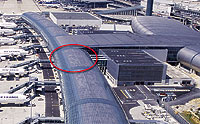...as external ties, the fingers are attached to the shell with tubular struts. The struts bear on recesses in the shell.
For some reason, still unknown, a handful of struts punched through the shell on one side of the isthmus building, say investigators. This destabilized more than 20 m of the structure.
The [challenge] is to understand how this structure became a mechanism, says Calgaro.
He suspects the answer lies in concrete movement caused by a combination of creep and thermal expansion. Passing through the airport at the time of collapse, Calgaro recalls the sun was bright but the ambient temperature at 7 a.m. was about 4°C.
 |
| NEAR ISTHMUS Fatal collapse occurred near connector building to main passenger terminal. (Photo courtesy of Laboratoire ADP/JL Fernandez) |
Investigators are treating the collapse area as an unusually complicated part of the structure because the shell abuts the isthmus building. Additionally, three sections of shell were omitted for passenger access from the main building. Click here to view drawing
The structurally identical area on the opposite side of the isthmus building is now propped, says Calgaro. But the bulk of the concourse is causing less concern because it has a regular profile, he adds.
Costing around $900 million, Terminal 2E was opened in June 2003. Architects and engineers from the operator, state-owned Aéroport de Paris, designed the complex and managed construction. Under a $32-million contract, Paris-based GTM Construction S.A., part of the Vinci group, erected the roof on a substructure built by another firm. Airport officials declined to comment on the report before completing a review. Vinci was unavailable for comment.
A forensic inves-tigation by the Paris General Prosecutors office may run through the summer, says an official. In line with French practice, the probe is looking at possible criminal liability for the collapse.
The entire terminal remains closed indefinitely.
|

Post a comment to this article
Report Abusive Comment